Industrial Sustainability: Lifting the Siege on Earth and Our Descendents
Industrial practices have a profound influence on environmental quality, natural resources, and human health and must be greatly altered if our descendents are to exist in a satisfactory state of well-being.
Serious environmental and health problems afflict most countries of the world, and inappropriate practices by industry, agriculture, and individuals are major causes. Industrial practices must be altered to become compatible, long-term, with protection of the environment and the well-being of humans. This is the essence of industrial sustainability.
 The objective of this article is to alert key personnel in the food industry to the fact that not only is adoption of sustainable practices important, but also that many of these practices will be economically advantageous over the long term.
The objective of this article is to alert key personnel in the food industry to the fact that not only is adoption of sustainable practices important, but also that many of these practices will be economically advantageous over the long term.
What Are the Problems?
Adoption worldwide of sustainable industrial practices is an urgent matter, as is evident from the serious environmental and health problems that plague the Earth:
• Global Warming and Depletion of Stratospheric Ozone. Global warming and alteration of atmospheric composition are issues of major concern to many leaders of the world.
Although global warming continues to be a contentious issue, more scientists, government officials, and industrialists are coming to the view that this is a problem of major importance (Figs. 1 and 2). Some have suggested a causal relationship between increased carbon concentration in the atmosphere and global warming, but this relationship, although reasonable, has not been established conclusively (Anonymous, 1994; Desai, 1992; Jamieson, 1998). It seems clear, however, that human economic activities are putting carbon into the atmosphere faster than the Earth’s flora and oceans remove it (Brown, 1996). Furthermore, CO2 inputs to the atmosphere have increased markedly and at an accelerating rate during the 20th century, especially in industrialized countries of the world (den Elzen et al., 1992).
Significant depletion of stratospheric ozone has occurred over the past several decades, and his is attributed mainly to release of chlorofluorocarbons and to jet travel through the stratosphere. Ozone concentrations over the northern hemisphere have declined about 13% since the 1970s, with the global average decrease being 3% (Chiras, 1998).
A 1988 conference in Canada (Environment Canada, 1988) generated the following sobering statement regarding human-induced changes in the composition of the atmosphere:
“Humanity is conducting an unintended, uncontrolled, globally pervasive experiment whose ultimate consequences could be second only to a global nuclear war. The Earth’s atmosphere is being changed at an unprecedented rate by pollutants resulting from human activities, inefficient and wasteful fossil fuel use and the effects of rapid population growth in many regions. These changes represent a major threat to international security and are already having harmful effects over many parts of the globe.
“Far-reaching impacts will be caused by global warming and sea-level rise, which are becoming increasingly evident as a result of the continued growth in atmospheric concentrations of carbon dioxide and other green-house gases. Other major impacts are occurring from ozone-layer depletion resulting in increased damage from ultra-violet radiation. The best predictions available indicate potentially severe economic and social dislocation for present and future generations, which will worsen international tensions and increase risk of conflicts between and within nations. It is imperative to act now.”
• Depletion of Ocean Fish Stocks. The world catch of marine fish reached a maximum level of about 100 million metric tons in 1989 and has remained fairly constant since then (Chiras, 1998). It is important to note, however, that this catch level has been sustained by substituting less-desirable species for favored species as the latter became depleted. For example, Atlantic cod, haddock, Atlantic mackerel, chub mackerel, saithe, and cape hake were among the top ten fish species in harvested weight in 1970, but none of these species was among the top ten catches in 1992 (Chiras, 1998). Data strongly indicate that current fish catches in all 17 major fisheries of the world have reached or exceeded limits of sustainability. In the Atlantic Ocean, 25 major locations have been overfished to the point where commercial fishing for the traditional species is no longer commercially viable (Fig. 3.)
--- PAGE BREAK ---
• Depletion of Forests. The world’s forested area, comprising 4.9 billion hectares in 1950, has declined to a current area of less than 2.0 billion ha (Pimentel and Pimentel, 1996). Most of this loss was caused deliberately by individuals and corporations. During the period 1981–90, 87 tropical countries lost approximately 1% of their forested area per year (WRI, 1992). To date, Africa and the United States have lost about one-third of their forests, and losses in Europe, Brazil, and the Philippines exceed 40% (Chiras, 1998). Clearly, the current rate of deforestation should not continue.
• Depletion of Nonrenewable Resources. Intuitively, one would suspect that many of the nonrenewable resources that are used in abundance today will, within several decades, become depleted sufficiently to curtail their use because of rising cost. This, however, is an overly simplistic view. Some nonrenewable resources, such as minerals, can be recycled, thus greatly forestalling the period of rising costs. For others, such as carbon-based energy sources, appropriate alternative energy sources will probably become available. Additionally, estimates of economical reserves often prove to be underestimated, leading to unduly pessimistic dates for scarcity. For example, the U.S. Bureau of Mines predicted in 1970 that supplies of minerals, such as lead, mercury, zinc, copper, and tin, assuming constant demand, would be exhausted by or before the year 2006 (USBM, 1970). The estimated exhaust date for petroleum was 2001. These estimates are clearly wrong by a wide margin, as are estimates of other groups such as the Club of Rome (Meadows et al., 1972).
Several studies have shown that the cost (inflation adjusted) of major nonrenewable resources has decreased greatly and quite steadily over the period extending from the late 1800s to the late 1900s, a trend that provides no indication of scarcity (Chiras, 1998). This trend probably will not continue indefinitely, but it does provide an indication that time is probably sufficient to forestall serious future shortages, provided sustainable practices for nonrenewable resources are adopted relatively soon.
• Pollution of Air, Water, and Soil. Pollution of air, water and soil, attributable to human activities, is sufficiently serious in many regions of the world that human health and agricultural production are seriously impaired. Impacts of waste discharge are small globally but severe in some locations, such as estuaries, coastal regions, and semi-enclosed seas like the Mediterranean and Baltic Seas (Clayton and Radcliffe, 1996). These local incidences of pollution are exceedingly important, as is evident from the following statement from the United Nations (UNCED, 1992):
“By the end of the century [year 2000] over 1 billion people will be without sufficient solid waste disposal services. Inadequate service can lead not only to the serious, long-term pollution of land, air and water resources but also bacterial and parasitic infections. The health impacts of this are particularly severe upon the urban poor. At present [1992], as many as 5 million people, 4 million under the age of 5, die each year from waste-related diseases.”
Fuel consumption is a major cause of air pollution:
“Mankind’s industrial, domestic and agricultural activities, notably fuel combustion, result in a wide range of emissions including sulfur dioxide (SO2), smoke, oxides of nitrogen (NOx), and volatile organic compounds (VOCs), into the atmosphere. These emissions are presently broadly comparable, on a global scale, to those derived from natural sources (mainly volcanoes, lightning and organisms in soils and the oceans). However, in the industrialised regions of Europe, North America and Asia, man-made emissions predominate, to the detriment of air quality and with corresponding effects on health, ecosystems and building materials, for example” (Anonymous, 1994).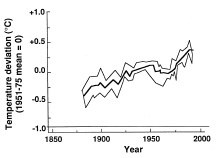
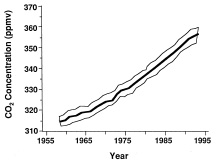
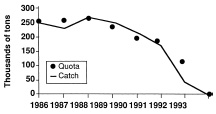 An additional cause of air pollution, particularly during 1998, was smoke from massive forest fires in Central and South America, Southeast Asia, and Africa. Aside from the worry of forest depletion, smoke from these fires has endangered the health of humans at the fire sites and at other areas of the world far removed from these sites (Linden, 1998).
An additional cause of air pollution, particularly during 1998, was smoke from massive forest fires in Central and South America, Southeast Asia, and Africa. Aside from the worry of forest depletion, smoke from these fires has endangered the health of humans at the fire sites and at other areas of the world far removed from these sites (Linden, 1998).
--- PAGE BREAK ---
In 1995, deliberate discharge of oil into the ocean (e.g., by flushing of the holds of oil tankers), another important cause of water pollution, was responsible for about 95% of the 2–5 million tons of oil annually entering the ocean via human activities (Clayton and Radcliffe, 1996).
Although economic activities historically have had generally negative impacts on environmental quality, there are exceptions. Some problems, such as inadequate sanitation and clean water, are associated with the lack of economic development (World Bank, 1992).
Also noteworthy is that recent emissions into the atmosphere of some undesirable pollutants have declined in several industrialized countries because of government regulations. Except for nitrogen oxide emissions from vehicles, which more than doubled during 1974–94, air quality in the United Kingdom has improved (Anonymous, 1994). Sulfur emissions, the main cause of acid rain, declined by almost half in the UK since the 1960s, and further substantial reductions are anticipated during the next 20 years (Anonymous, 1994). Air quality in the U.S. and Canada has improved in many respects since the early 1970s (Table 1).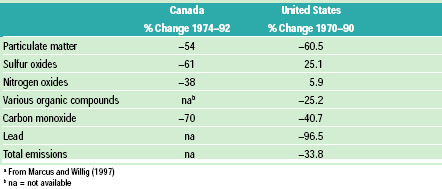
Although some companies, or even business sectors, in several regions of the world have made important progress in lessening pollution, global pollution of air, water, and soil by industrial activities remains grossly inconsistent with human well-being.
• Scarcity of Water for Drinking and Agriculture. Severe water shortage is currently a problem of critical importance in many regions of the world, and more nations will surely encounter this problem in the future. According to Helmut O. Maucher, Chairman of the Board and Chief Executive Officer of Nestlé, S.A., “Pure water in densely populated towns and cities will be one of the major challenges in the 21st century” (Anonymous, 1991). Furthermore, according to Brown (1996), “In 26 countries—home to 230 million people—scarce water limits food production, economic development, sanitation, and environmental protection.” The number of people residing in water-scarce or water-stressed nations as a function of time is shown in Fig. 4.
Globally, there is no shortage of water, but 97% of this water is saline. Of the remaining 3% that is fresh, 0.6% is surface water, 21.8% is groundwater, and 77.6% is ice and snow (UNEP, 1988). Surface water is the most economical to use, and when its supply becomes limited, usually driven by population increases, conflicts can be intense. The Colorado River basin is an example. Use of water from this source has become so intense that in years of normal or subnormal precipitation, this river runs dry before it reaches its final destination in the Sea of Cortez (Brown, 1996).
The reasons for increasingly severe shortages of water are fairly obvious: (1) increasing world population that drives increasing water demands by agriculture and industries; (2) slow adoption of water conservation practices (e.g., in many urban centers in developing countries, loss of more than half of the treated water is due to leaks, and inefficient irrigation procedures are commonplace); (3) slow implementation of projects to improve access to fresh water; and (4) uneven availability and distribution of existing water sources (Hillary, 1997; Owen et al., 1998). During 1950–70, global use of water doubled (Firor, 1990), a rate of use that will be exceedingly difficult, or more likely impossible, to maintain (Rivière, 1989).
--- PAGE BREAK ---
Globally, the agricultural and industrial sectors are the primary users of water. Agriculture is responsible for 90% of water use, industry 7%, and domestic use the remainder. Most of this water comes from surface sources—rivers, streams, and lakes—and competition for these sources is becoming increasingly severe in many parts of the world (Chiras, 1998). Waterways often serve as boundaries between countries, making conflict over access to this water more likely. Approximately 148 rivers are shared by two countries, and about 52 rivers are shared by three or more countries. Several rivers are shared by as many as 10 countries (Clayton and Radcliffe, 1996).
Irrigation of crops has greatly increased and spread to many countries of the world where it was at one time uncommon. In 1800, 8 million ha were irrigated worldwide, compared to 48 million in 1900, 94 million in 1950, and 250 million in 1989 (Postel, 1989). This has resulted in greatly increased crop yields but a steady depletion of surface and groundwater reserves. Less than 0.1% of the stored groundwater mined annually by pumping is replaced (UNEP, 1991). Clearly, the increased use of irrigation is unsustainable globally because it accounts for more than 70% of human use.
As a result of improper irrigation practices, the Aral Sea, once the fourth largest inland sea in the world, has lost more than half of its water. The fishing fleet that remains operates from a site 40 km removed from the original harbor (Kula, 1994).
Israel has been highly successful in adopting improved irrigation practices. Since 1951, irrigated acreage has steadily increased and water application per acre has decreased (Anonymous, 1997). Other countries would be well advised to emulate this performance. 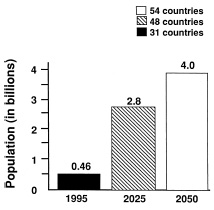
• Extinction of Species. Why the public should be concerned about this matter is less obvious than for the problems discussed above. There are, however, compelling reasons to be concerned about extinction of species and variants of species, or, as it is often referred to, loss of biodiversity: (1) civilized society has accepted, as a moral principle, the desirability of avoiding needless harm to nonhuman species, and (2) loss of biodiversity, or even disturbance of the delicate balance among nonhuman species, can have highly adverse effects on humans.
The latter point deserves further attention. First, it is important to recognize that many important pharmaceuticals are derived from nonhuman species, e.g., steroids, penicillin, digitalis, morphine, and aspirin. More specifically, potent antibiotics have been obtained from frogs, and anticancer drugs from the bark of the Pacific yew tree and the dogfish shark (Swerdlow, 1999). Furthermore, much has been learned about human sight by decoding the visual system of the horseshoe crab (Morell, 1999). From a solely selfish view, loss of a species constitutes an irreversible loss of chemicals and drugs that may be of value to humans.
Second, imbalances in nature, created either through loss of one or more species or through emergence of a dominating new species, can cause problems, some of which affect humans. Elimination of predators from Wisconsin has led to an abundance of deer, and their eating habits have significantly altered the flora in some regions. Once rabbits were introduced into Australia, they quickly became a nuisance because natural predators were lacking. Alewives inadvertently introduced into the Great Lakes have damaged populations of desirable fish species. Snails and zebra mussels, also introduced inadvertently into the Great Lakes, have caused troublesome clogging of tubes carrying cooling water to electrical generating plants.
--- PAGE BREAK ---
Loss of a keystone species—one that other organisms depend on for survival—survival—can be especially damaging. The sea otter is a keystone species in the Pacific Ocean. Otters feed on abalone, crabs, mollusks, and sea urchins that live in kelp beds. In the absence of otters, sea urchins proliferate, their consumption increases, and kelp beds sometimes disappear (Chiras, 1998). Many keystone species exist, and their elimination causes a cascade of effects, some of which may not be evident for years.
Despite these compelling reasons to maintain biodiversity, we are failing to do so. Natural extinction, of course, has occurred since the beginning of life on Earth, but this process is slow, except during periods of natural disasters. Accelerated extinction of species became evident in the past few centuries and was largely the result of human activities. This human-induced extinction of species is estimated to be responsible for the loss of 40–100 species per day, with perhaps 3–5% being lost per decade (Barbier et al., 1994; Chiras, 1998). This rate is many times greater than that of natural extinction. The primary causes are the alteration/destruction of natural ecosystems and the commercial hunting and harvesting of wild species (Chiras, 1998).
It seems indisputable that maintenance of biodiversity must be an essential part of any program of sustainable development.
• Excessive Population Growth. Overpopulation of humans is a major problem in many parts of the world and is likely to worsen in the next several decades. According to the World Resources Institute (WRI, 1997), the urban population of the world is estimated to increase to more than 5 billion people in the next 35 years, more than double the present population. About 90% of this growth is expected to occur in developing countries, many of which are unable to provide the current population with diets, clothing, housing, and health services that meet reasonable minimum standards of well-being. Furthermore, total world population is expected to increase from the current 6 billion to about 9.4 billion by 2025, not stabilizing until 15 billion is attained in 2100 (Pimentel and Pimentel, 1996). If these projections are correct, achieving sustainable development will be difficult, if not impossible. Accentuating the problem is the fact that most religions do not favor birth control (Kula, 1994).
Population growth rates are location dependent (Table 2). Today, about 50 developed countries have nearly stationary or declining populations (Chiras, 1998). It also should be noted that growth rates of the world population and of developing countries as a group have been declining since about 1965, but this does not contradict the global estimates cited above.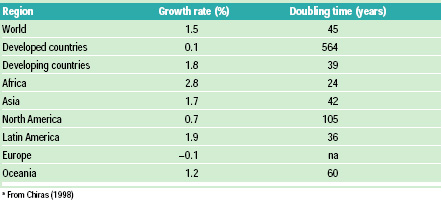
According to Chiras (1998), “overpopulation is at the root of virtually all environmental problems, including pollution and resource depletion, and many social and economic problems.” Agricultural and industrial activities that have globally pronounced adverse effects are often associated with increases in population density. Consequently, the need for sustainable development/industrialization practices becomes increasingly compelling with increases in population density.
What Are the Options?
Whether economic growth, a high-quality environment, and an acceptable state of human health and well-being can be sustained in perpetuity is a question that has been hotly debated. “Limits to growth” debates have occurred for more than three centuries, and a consensus view is no closer to being achieved (Tisdell, 1990). The argument will not be resolved here, so the best that can be done is to lay out the three growth options and indicate the one that has been adopted by most leaders of the world.
--- PAGE BREAK ---
• No Growth. Some argue that economic growth as practiced in the Western world for the past century cannot occur without severe damage to the environment and to the health and wellbeing of humans. According to this view, technological progress will not be able to counteract the onset of resource scarcity, as it has done in the past, and adequate protection of human health and the environment cannot be achieved unless economic growth is severely curtailed (Jordan, 1995; Kula, 1994).
There is serious concern about the movement of multinational corporations into lesser-developed countries of the world, most of which are ill-equipped to control their behavior. There is also evidence to indicate that economic growth, although deemed desirable by most countries, does not necessarily lead to a substantial increase in per capita income and alleviation of poverty. Instead, the main benefits of economic growth tend to flow to the moderately to very wealthy segments of society (Owen et al., 1998). Nonetheless, a “no-growth” policy is not considered a valid option by national governments and international agencies.
• Unlimited Growth. The view that economic growth should be allowed to occur unfettered has long ago been abandoned by governments and almost all individuals. No responsible government or individual, in light of the environmental problems enumerated above, can build a convincing argument for this approach.
• Sustainable Development. Some believe that scarcity of resources and environmental factors are not likely to pose significant impediments to economic growth. Technological advances, in their view, will lead to more efficient use of nonrenewable resources, reasonable substitutes for scarce resources, and recycling of scarce nonconsumable resources, such as metals. They also believe that economic growth and protection of environmental quality can be compatible, even though historical examples of severe damage to the environment by industrial activities are undeniable (Tisdell, 1990). Compatibility becomes possible, according to this view, when economic growth is allowed to occur in a carefully controlled fashion. The underlying principle is that growth must be environmentally prudent, have neutral or positive effects on human health and well-being, and be sustainable for many future generations. This is the view held by most governments and responsible individuals the world over.
This kind of controlled economic growth has been given the name “Sustainable Development.” A UN Commission, chaired by Gro Brundtland, defined sustainable development as “Development that meets the needs of the present without compromising the ability of future generations to meet their own need” (WCED, 1987). “Industrial Sustainability” is the term I have chosen to describe that part of sustainable development that deals specifically with industrial practices.
Many other definitions of sustainable development have arisen since publication of the Brundtland report, these being stimulated by the lack of specificity of the Brundtland definition. Rather than discuss alternative definitions, it is more useful, in my view, to discuss what must be done globally to achieve a condition of sustainable development.
Requirements of Sustainable Development and Roles of Participants
The requirements of sustainable development are listed in Table 3. They are imposing and cannot be met, even marginally, by many countries of the world unless action from international organizations, national governments, the business community, and the public is unified and persistent.
• International Organizations. Several international organizations, initially stimulated by the UN, have promoted practices that will lead to sustainable development. Some of the major activities, listed chronologically, appear in the sidebar on page 47 (Anonymous, 1994; Brown and Lemons, 1995; Hillary, 1997; Rappaport and Flaherty, 1992). Not all international initiatives in the area of sustainable development have been covered, but the list should be sufficient to demonstrate that this is an important issue and that interest by the UN, the international business community, and private international organizations is intense.
--- PAGE BREAK ---
• Governments. National and regional governments bear primary responsibility to foster sustainable development practices by the public and those engaged in economic endeavors, and they have a powerful array of tools to meet their responsibility (Table 4). However, the zeal with which various nations undertake this role varies greatly. In developing countries, few have effective laws and regulations pertaining to practices that negatively affect the environment, and some have none (Marcus and Willig, 1997). Worse still, in those developing countries where laws and regulations do exist, they are often poorly enforced (Rappaport and Flaherty, 1992). In developed countries, reasonable laws and regulations pertaining to environmental practices usually do exist, but enforcement practices differ greatly in effectiveness. Typically, penalties for pollution are too feeble to act as effective deterrents of undesirable activities (Lanoie et al., 1998).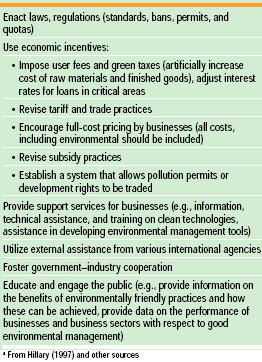
Industrialized nations have undergone profound changes in their response to pollution and environmental degradation. The first and centuries-long approach was to ignore these matters. The next approach was “dilution,” and this was followed some decades later by “control.” Finally, the concept of “prevention” emerged, and it has become the dominant philosophy in responsible countries and companies (Hillary, 1997).
Several national and regional organizations that have been strong forces in encouraging industrial practices of an environmentally friendly nature are worthy of mention (Pietro and Breen, 1999):
U.S. Environmental Protection Agency (EPA), in association with the Los Alamos National Laboratories, Los Alamos, N.M; the American Chemical Society, Washington, D.C.; and the Green Chemistry Institute, Rockville, Md.
University of Venice’s Cà Foscari (House of Foscari), Venice, Italy, in association with the Italian Inter-university Consortium on Chemistry for the Environment (INCA).
University of York, in association with the Royal Society of Chemistry and the Institute for Applied Catalysis, in the United Kingdom.
University of Science and Technology of China, Center for Green Science and Technology, Hefei, Anhui Province, People’s Republic of China.
Monash University, Melbourne, Australia.
Swedish Foundation for Strategic Environmental Research (MISTRA), Stockholm, Sweden. (MISTRA), Stockholm, Sweden.
• The Public. Public support for practices that are environmentally friendly and sustainable is essential if attempts to adopt these practices are to succeed (Anonymous, 1997; Clayton and Radcliffe, 1996). Gaining the public’s support for these practices is not easy, since their adoption involves changes in aspirations, patterns of consumption, and, in general, changes in daily behavior. There are, however, encouraging indications, at least in developed countries of the world, that public concern about environmental matters is intensifying (Rappaport and Flaherty, 1992). In developing countries of the world, especially those in which the standard of living is low and food is scarce, public sentiment for adopting sustainable practices that protect the environment is understandably weak. Clearly, achievement of a critical level of prosperity is necessary before the public is willing to give attention to sustainable practices and protection of the environment. It is the hope of many that sustainable development practices, in those countries that are presently economically disadvantaged, will raise mean levels of prosperity to the point where public support for protecting the environment will emerge.
--- PAGE BREAK ---
• Businesses. An innate characteristic of the free enterprise system is that a company’s survival depends on financial success. Consequently, a primary focus on maximizing profits (improving operating margins, increasing sales and market share) is both understandable and necessary. In the 20th century, satisfying legal requirements has emerged, for most companies, as a priority of almost equal importance. Activities that are considered beneficial to corporate welfare but are financially neutral come next in order of priority, followed last by activities that are necessary but financially burdensome (Callenbach et al., 1993).
Historically, corporate management has held the view that operational practices tailored to protect the environment and help assure sustainability fall within the financially neutral to negative categories and are thus matters of low priority. Evidence for this is glaringly evident in the form of numerous business-created environmental problems (soil, water, and air pollution and abuse of natural resources, such as forests and marine stocks of fish).
Fortunately, attitudes of many key managers of large corporations are changing in a very desirable direction, and this is especially noticeable in the past 20 years. Some may question the change in attitude, but there is supportive evidence. For example, Rappaport and Flaherty (1992) in 1990 surveyed 98 U.S.-based multinational corporations with aggregate sales of $48 billion in 1989 and 211,000 employees. In response to the statement, “Stronger environmental regulations cause decreased productivity,” 55% disagreed or strongly disagreed, and only 19% agreed or strongly agreed. Evidence collected by the World Business Council for Sustainable Development, mostly from its membership, indicates “an identifiable change of course—a paradigm shift—away from a fractured view of the environment and development issues, to a holistic view of business and sustainable development” (Schmidheiny et al., 1997). Furthermore, the International Chamber of Commerce developed a 16-point “Business Charter for Sustainable Development,” and the first principle on corporate priorities is “To recognize environmental management as among the highest corporate priorities and as a key determinant to sustainable development, [and] to establish policies, programmes and practices for conducting operations in an environmentally sound manner” (ICC, 1991).
A management attitude intended to prevent environmental degradation would not have emerged in the business community without compelling reasons, and these are enumerated in Table 5.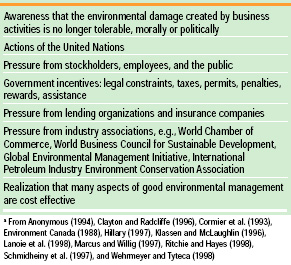
Adoption of a management philosophy that regards protection of the environment and sustainable practices as matters of high priority has far-reaching operational consequences. Changes that must be instituted include the following (Clayton and Radcliffe, 1996; Ritchie and Hayes, 1998; Schmidheiny et al., 1997; Shen, 1997; Van der Horst and Zweers, 1994):
1. Establish, at the highest level of management, a company commitment to operational practices that are environmentally friendly.
2. Acquire accurate information about company operations worldwide, particularly about joint ventures and subsidiaries.
3. Formulate a plan with objectives and targets. This plan cannot be properly developed without knowing what practices are most appropriate from an environmental standpoint. “Life cycle assessments” for each product are needed to gain this information. This is a method for determining the total environmental impact of alternative approaches to each step in the product system—from the farm level through formulation, processing, packaging, handling, storage, and distribution. An example is the recently reported life cycle assessment of tomato ketchup (Andersson and Ohlsson, 1999).
4. Implement the plan. Major objectives are worker safety and healthfulness, pollution prevention, and resource conservation. This will involve, but not be limited to environmental audits, employee training, effective preventive maintenance, proper material handling procedures, proper record keeping and reporting, and process modification (e.g., adopt in-process recycling, improve cleaning processes, use chemical catalysts, reduce generation of hazardous wastes, reduce energy consumption, increase use of recycled materials, reduce packaging materials, use packaging materials that can be reused or recycled by consumers).
--- PAGE BREAK ---
5. Monitor and evaluate the effectiveness of new practices.
6. Establish uniform environmental, health, and safety practices throughout all countries in which the company has financial interests.
There are advantages to businesses for conformance to recommended environmental management practices. Many CEOs are unaware of this and still resist the idea that sound practices of environmental management and sustainability should rank high in management priorities.
Although implementation of an environmental management program does involve a substantial cost, in many instances the savings resulting from such a program can more than counterbalance the cost (Ritchie and Hayes, 1998). These potential savings are listed in Table 6. Implementation by companies of appropriate environmental management practices has the additional benefit of enhancing the well-being of the public, including their customers.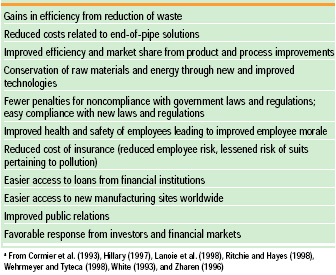
Attaining Sustainable Industrialization
Attainment of sustainable industrial practices worldwide is a difficult task because of the imposing requirements enumerated in Table 3. Progress is being made, but the degree of success varies greatly among countries and businesses. In developed countries, progress is encouraging. In developing countries, especially those that are most impoverished, progress is slow, and, in many instances, discouraging. This is quite understandable; a populace living in poverty is concerned with the immediate necessities of life—food, clothing, and shelter—not with quality of the environment, conservation of natural resources, or preservation of biodiversity.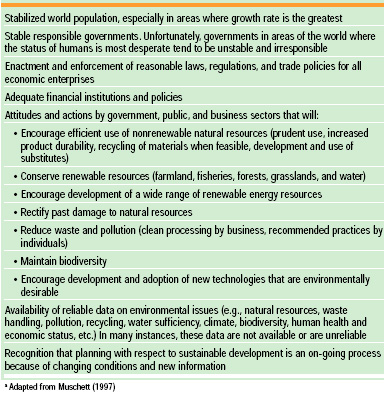
Globally, the business community has moved in the direction of sustainable practices, but progress has varied greatly among companies and has been generally slow because of serious impediments (Rappaport and Flaherty, 1992; Schmidheiny and Zorraquin, 1997; Van der Horst and Zweers, 1994):
• Many business managers are still unfamiliar with the importance of adopting environmental management practices and are poorly informed regarding what these practices entail in areas such as management training, special skills required, collection of pertinent information, monitoring of operations, and product and process development.
• Low resource prices discourage efficient use of resources.
• Accounting and reporting practices do not adequately convey the costs of irresponsible environmental management, or potential environmental risks and opportunities.
• Benefits of good environmental management are realized in the long term, whereas industrial results are typically judged in the short term.
• Progress toward good environmental management is difficult to measure.
• In many developing countries, effective laws and regulations regarding environmental practices by industrial firms do not exist and, even when they do, are often inadequately enforced.
--- PAGE BREAK ---
Historically, large corporations involved in areas such as mining, petroleum, and the manufacture of chemicals and heavy steel-based products have followed practices that were most damaging to the environment and human health. Therefore, the advocates of sustainable development practices (the UN and governments in many developed nations) have focused primary attention on this segment of the business community. The response from managers in these industries has been, for the most part, encouraging. Many multinational corporations have voluntarily adopted practices that are more consistent with sustainable industrialization. These improved practices can be attributed to an increased awareness by CEOs of large, multinational corporations that the issue of industrial sustainability is serious—an awareness created by actions of the UN and several national governments. A major consequence of this awareness was the development of guidelines for sustainable industrial practices by several business trade associations (Global Environmental Management Initiative, see sidebar; ICC, 1991; WBSCD, 1999) and by ISO (Ritchie and Hayes, 1998).
The opinions of CEOs of small multinational, national, regional, and local corporations, many of whom manage food-related businesses, is less well known. However, it is reasonable to suspect that this group of industrial managers is not well informed on the subject of industrial sustainability and is generally uncommitted to the principles involved. I hope this article will help educate this group of managers and thereby provide them with an incentive to adopt the practices underlying sustainable industrialization.
Movement toward industrial practices that are sustainable globally is irreversible, but progress is, and will continue to be, erratic and fraught with controversy. Ecological disasters or new information about adverse effects of the environment on human health will trigger spurts of intense progress, and this, unfortunately, will be followed by periods of inaction (Fig. 5). This likely scenario is troubling because current abusive practices, even if short-lived, may have undesirable effects on the environment and/or human health that are difficult or impossible to reverse. Furthermore, as conditions change and new information becomes available, requirements for industrial sustainability are certain to change, no doubt in the direction of becoming more demanding.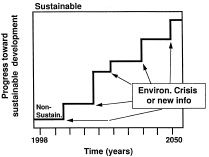
Although impediments to achieving global industrial sustainability are formidable, so are the increasingly powerful forces working to achieve this operational mode—the UN, most national governments of the world, trade and scientific associations, many leaders of large businesses, and numerous individuals. The outlook, therefore, is moderately encouraging. If we advance successfully along the path to industrial sustainability our descendents will be most grateful; if not, we will be reviled.
Some International Organizations that Have Promoted Practices that will Lead to Sustainable Development and Sustainable Industrialization
United Nations Conference on Human Environment. This conference, held in Stockholm, Sweden, in 1972, challenged the industrialized world to remedy problems that uncontrolled industrial development is causing. An outcome was creation of the UN Environment Program (UNEP), which was charged with building environmental awareness and stewardship.
UNEP and the International Chamber of Commerce (ICC). This group organized “The World Conference on Environmental Management” in 1984. One of the goals was to strengthen the anticipatory and preventive approach to environmental management within industry.
World Resources Institute. This organization convened a panel of business leaders to discuss the role of multinational corporations in improving cooperation with developing countries regarding environmental matters. Some of the recommendations (WRI, 1992) were that corporate policies and practices should be in accord with the host country’s laws and regulations, and that the corporate policy must be set and enforced at the highest level of management.
--- PAGE BREAK ---
World Commission on Environment and Development. This commission, headed by Gro Burndtland, published Our Common Future in 1987 (WCED, 1987). The term “Sustainable Development” was first used in this document. The commission’s list for industry action (Rappaport and Flaherty, 1992) included accepting a broad sense of social responsibility; ensuring environmental awareness at all levels; and establishing company-wide policies regarding resource use and environmental management, “including compliance with the laws and requirements of the countries in which they operate.”
Second World Industry Conference on Environmental Management. This conference, called WICEM II, was organized by ICC and held in April 1991. A 16-point Business Charter for Sustainable Development was developed (ICC, 1991).
The United Nations Conference on Environment and Development (UNCED). This conference, also known as the Earth Summit, was held in Rio de Janeiro in June 1992 (Johnson, 1993). Major products from this conference were:
• Agenda 21, a 40-chapter blueprint for international action in the 21st century on environmental protection and sustainable development, regarded by many as one of the most important international agreements ever achieved. The major purpose of the agreement is to bring human activities into harmony with nonhuman life and prudent management of the environment. For the first time, signatory nations are expected to govern in a manner that integrates environmental, economic, and social planning.
• Treaty on Climate Change, guidelines for reduction of greenhouse gases.
• Treaty on Biodiversity, strategies for maintaining biodiversity and creating inventories of species to be preserved.
• Rio Declaration on Environment and Development, a set of 27 principles on sustainable development, several of the most significant of which are that nations should not cause damage to the environment of other states and areas beyond their borders; alleviating poverty and reducing disparities in worldwide standards of living are important elements of sustainable development; costs involved in remedying pollution should, in principle, be borne by the polluters; states should avoid exporting activities or substances that endanger life or the environment; and scientific uncertainty should not be a reason to avoid taking remedial action in situations where potential harm to the environment is great (Brown and Lemons, 1995).
• Declaration on Forest Management, a statement of principles for the management, conservation, and sustainable development of the world’s forests.
World Business Council for Sustainable Development (WBCSD). Prior to the previous conference, the Secretary-General of UNCED asked Stephan Schmidheiny, a Swiss industrialist, for advice on business matters. Part of his response was to establish WBCSD in 1995 (WBCSD, 1999). This organization, in turn, sought advice from two international standards organizations: the International Standards Organization (ISO) and the International Electrotechnical Commission (IEC). These two organizations established the Strategic Advisory Group on the Environment (SAGE).
--- PAGE BREAK ---
ISO, located in Geneva, Switzerland, was founded in 1947 to develop consensus international standards for manufacturing, trade, and communications, the adoption of which is voluntary (Ritchie and Hayes, 1998). This privately funded organization has representatives from more than 100 countries. The ISO 9000 series is probably its best-known previous accomplishment. At WBCSD’s request, it developed the ISO 14000 series that pertains to environmental management systems (Clements, 1996; Marcus and Willig, 1997; Zharen, 1996). Several components of this series are 14000: Environmental Management Systems—Guidelines and Principles; 14001: Environmental Management Systems—Specifications and Use Guidelines; 14010: Guidelines for Environmental Auditing—General Principles; 14011.1: Guidelines for Environmental Auditing—Procedures; 14012: Guidelines for Environmental Auditing—Qualification Criteria for Auditors; and 14060 Guide for the Inclusion of Environmental Aspects in Product Standards.
UN Commission on Sustainable Development. This commission was created in 1992 to monitor world progress of implementation of Agenda 21 and other Rio agreements.
Other international business organizations that have contributed to guidelines for responsible environmental management:
• International Petroleum Industry Environment Conservation Association.
• Global Environmental Management Initiative (GEMI). This organization was formed by ten U.S. multinational corporations and now includes about 200 CEOs representing a broad array of industries. Its stated goals are to stimulate, assemble, and promote worldwide critical thinking on environmental management; improve the environmental performance of businesses worldwide through example and leadership; promote a worldwide business ethic for environmental management and sustainable development; enhance the dialogue between business and its interested publics such as non-governmental organizations, government, and academia; and forge partnerships around the world to encourage similar efforts in other countries in addition to the U.S.
• International Food Policy Research Institute. International Food Policy Research Institute. This organization, based in Washington, D.C., has developed a “2020 Vision of the World,” the goal of which is to achieve a state where every person has economic and physical access to sufficient food to sustain a healthy and productive life, where malnutrition is absent, and where food originates from efficient, effective, and low-cost food and agricultural systems that are compatible with sustainable use and management of natural resources.
by OWEN FENNEMA
The author, 1982–83 President of IFT, is Professor Emeritus of Food Chemistry, Dept. of Food Science, University of Wisconsin, Madison, WI 53706. This article has been peer reviewed.
References
Anderson, K. and Ohlsson, T. 1999. Including environmental aspects in production development: A case study of tomato ketchup. Lebensm.-Wiss. u. Technol. 32: 134-141.
Anonymous. 1991. “2 Million Years of the Food Industry.” Nestlé, Geneva, Switzerland.
Anonymous. 1994. “Sustainable Development: The UK Strategy,” Cm 2426. HMSO Publications Center, London, U.K.
Anonymous. 1997. “Five Years After Rio: Innovations in Environmental Policy.” World Bank, Washington, D.C.
Barbier, E.G., Burgess, J.C., and Folke, C. 1994. “Paradise Lost?—The Ecological Economics of Biodiversity.” Earthscan, London.
Brown, L.R. 1996. “State of the World.” W.W. Norton, New York.
Brown, D.A. and Lemons, J. 1995. Introduction. In “Sustainable Development: Science, Ethics, and Public Policy,” ed. J. Lemons and D.A. Brown, pp. 1-10. Kluwer Academic Pub., Dordrecht, The Netherlands.
Callenbach, E., Capra , F., Goldman, L., Lutz, R., and Marburg, S. 1993. “EcoManagement: The Elmwood Guide to Ecological Auditing and Sustainable Business.” Berrett-Koehler Pub., San Francisco.
Chiras, D.D. 1998. “Environmental Science: A Systems Approach to Sustainable Development,” 5th ed. Wadsworth Pub. Co., Belmont, Calif.
Clayton, A.M.H., and Radcliffe, N.J. 1996. “Sustainability: A Systems Approach,” Westview Press, Boulder, Colo.
Clements, R.B. 1996. “Complete Guide to ISO 14000.” Prentice Hall, Englewood Cliffs, N.J.
Cormier, D., Magnan, M., and Morard, B. 1993. The impact of corporate pollution on market valuation: Some empirical evidence. Ecol. Econ. 8: 135-155.
den Elzen, M., Janssen, M., Rotmans, J., Swart, R., and de Vries, B. 1992. Allocating constrained global carbon budgets: Inter-regional and inter-generational equity for a sustainable world. Intl. J. Global Energy Issues 4: 287-301.
Desai, A.V. 1992. Energy and sustainable development. Intl. J. Global Energy Issues 4: 240-246.
Ekins, P. 1993. “Limits to growth” and “sustainable development,” Grappling with ecological realities. Ecol. Econ. 8: 269-288.
Environment Canada. 1988. Conference statement. In “The Changing Atmosphere: Implications for Global Security,” Toronto, July 27-30.
Firor, J. 1990. “The Changing atmosphere: A Global Challenge.” Yale Univ. Press, New Haven, Conn.
FRCC. 1993. “Report on the Status of Groundfish Stocks in the Canadian Northwest Atlantic.” Fisheries Resource Conservation Council, Dept. of Fisheries and Oceans, Ottawa, Canada.
Hillary, R. 1997. “Environmental Management Systems and Cleaner Production.” John Wiley & Sons, New York.
Hinrichsen, D., Robey, B., and Upadhyay, U.D.1998. Solutions for a water-short world. Population Repts., Series M, No. 14, Johns Hopkins Univ. School of Public Health, Baltimore, Md.
ICC. 1991. The business charter for sustainable development, Principles for environmental management. Pub. 210/356A. Intl. Chamber of Commerce, Paris.
Jamieson, D. 1998. Sustainability and beyond. Ecol. Econ. 24: 183-192.
Johnson, S.P. 1993. “The Earth Summit,” The United Nations Conference on Environment and Development (UNCED). Graham & Trotman/Martinus Nijhoff, London.
Jordan, C.F. 1995. “Conservation: Replacing Quantity with Quality as a Goal for Global Management.” John Wiley & Sons, New York.
Keeling, C.D. and Whorf, T.P. 1994. Atmospheric CO2 records from sites in the SIO air sampling network. In “Trends ’93: A Compendium of Data on Global Change,” ed. R.A. Boden, D.P. Kaiser, R.J. Sepanski, and F.W. Stoss, pp. 16-26. Oak Ridge National Laboratory, Oak Ridge, Tenn.
Klassen, R.D. and McLaughlin, C.P. 1996. The impact of environmental management on firm performance. Mgmt. Sci. 42: 1199-1214.
Kula, E. 1994. “Economics of Natural Resources, the Environment and Policies.” Chapman & Hall, London.
Lanoie, P., Laplant, B., and Roy, M. 1998. Can capital markets create incentives for pollution control? Ecol. Econ. 26: 31-41.
Linden, E. 1998. Smoke signals. Time 151(24): 50-51.
Marcus, P.A. and Willig, J.T. 1997. “Moving Ahead with ISO 14000.” John Wiley & Sons, New York.
Meadows, D.H., Meadows, D.L., Randers, J., and Behrens, W.W. III. 1972. “The Limits to Growth.” Universe Books, New York.
Morell, V. 1999. The variety of life. Natl. Geographic, Feb., pp. 6-31.
Muschett, F.D. 1997. An integrated approach to sustainable development. In “Principles of Sustainable Development,” ed. F.D. Muschett, pp. 1-45. St. Lucie Press, Delray Beach, Fla.
Owen, O.S., Chiras, D.D., and Reganold, J.P. 1998. “Natural Resource Conservation: Management for a Sustainable Future.” Prentice Hall, Upper Saddle River, N.J.
Pietro, T. and Breen, J.J. 1999. A center for green chemistry on the continent. Today’s Chemist at Work 8(2): 52-59.
Pimentel, D. and Pimentel, M. 1996. “Food, Energy, and Society,” rev. ed. Univ. Press of Colorado, Boulder.
Postel, S. 1989. Water for agriculture: Facing the limits. Worldwatch paper 93. Worldwatch Inst., Washington, D.C.
Rappaport, A, and Flaherty, M.F. 1992. “Corporate Responses to Environmental Challenges: Initiative by Multinational Management.” Quorum Books, New York.
Ritchie, I. and Hayes, W. 1998. “A Guide to the Implementation of the ISO 14000 Series on Environmental Management.” Prentice Hall, Upper Saddle River, N.J.
Rivière, J.W. 1989. Threats to the world’s water. Sci. Am. 26(3): 80-94.
Ruitenbeek, H.J. 1996. The great Canadian fishery collapse: Some policy lessons. Ecol. Econ. 19: 103-106.
Schmidheiny, S. and Zorraquin. J.L. 1997. Eco-efficiency and the financial markets. In “Bridges to Sustainability: Business and Government Working Together for a Better Environment,” ed. L. Gomez-Echeverri, p. 105. Yale Univ., New Haven, Conn.
Schmidheiny, S., Chase, R., and De Simone, L. 1997. Business progress toward sustainable development. In “Bridges to Sustainability: Business and Government Working Together for a Better Environment,” ed. L. Gomez-Echeverri, p. 143. Yale Univ., New Haven, Conn.
Shen, T.T. 1997. Technologies for sustainable development. In “Principles of Sustainable Development,” ed. F.D. Muschett, pp. 83-130. St. Lucie Press, Delray Beach, Fla.
Swerdlow, J.L., 1999, Biodiversity: Taking stock of life. Natl. Geographic, Feb. 2-5, pp. 83-130.
Tisdell, C.A. 1990. “Natural Resources, Growth, and Development: Economics, Ecology, and Resource Scarcity.” Praeger, New York.
UNCED. 1992. “The Global Partnership for Environment and Development: A Guide to Agenda 21.” United Nations Conference on Environment and Development, United Nations, Geneva, Switzerland.
UNEP. 1988. “Safeguarding the World: Water.” UNEP Environment Brief 6. United Nations Environment Programme, Nairobi, Nigeria.
UNEP. 1991. “Freshwater Pollution.” Global Environment Monitoring System. United Nations Environment Programme, Nairobi, Nigeria.
USBM. 1970. “Mineral Facts and Problems.” U.S. Bureau of Mines. U.S. Govt. Print. Office, Washington, D.C.
Van der Horst, T.J.J., and Zweers, A. 1994. Environmentally oriented product development—Various approaches to success. J. Eng. Design 5: 37-44.
Vinnikov, K.Ya., Groisman, P.Ya., and Lugina, K.M. 1994. Global and hemispheric temperature anomalies from instrumental surface air temperature records. In “Trends ’93: A Compendium of Data on Global Change,” ed. T.A. Boden, D.P. Kaiser, R.J. Sepanski, and F.W. Stoss, pp. 615-627. Oak Ridge National Laboratory, Oak Ridge, Tenn.
WBCSD. 1999. www.wbscd.ch/whatis.htm.
WCED. 1987. “Our Common Future” (G.H. Brundtland, Commission Chair). World Commission on Environmental and Development, Oxford Univ. Press, Oxford, U.K.
Wehrmeyer, W. and Tyteca, D. 1998. Measuring environmental performance for industry: From legitimacy to sustainability and biodiversity? Intl. J. Sustain. Dev. World Ecol. 5: 111-124.
White, R.R. 1993. “North, South, and the Environmental Crisis.” Univ. of Toronto Press, Toronto, Canada.
World Bank. 1992. “World Development Report 1992.” Oxford Univ. Press, Oxford, U.K.
WRI. 1992. “World Resources 1992-93.” World Resource Inst., Oxford Univ. Press, New York.
WRI. 1997. “World Resources Report, 1996-97.” World Resource Inst., Oxford Univ. Press, New York.
Zharen, W.M. von. 1996. “ISO 14000: Understanding the Environmental Standards. Government Institutes, Rockville, Md.
Oral versions of this article were presented at Ontario Agricultural College’s 125th Anniversary, Guelph, Ont., Canada, January 25, 1999; the 1st National Congress on the Science and Technology of Foods, San Jose, Costa Rica, July 19-21, 1999; and the International Division Symposium at the Annual Meeting of the Institute of Food Technologists, Dallas, Tex., June 11, 2000.
Edited by Neil H. Mermelstein,
Senior Editor
